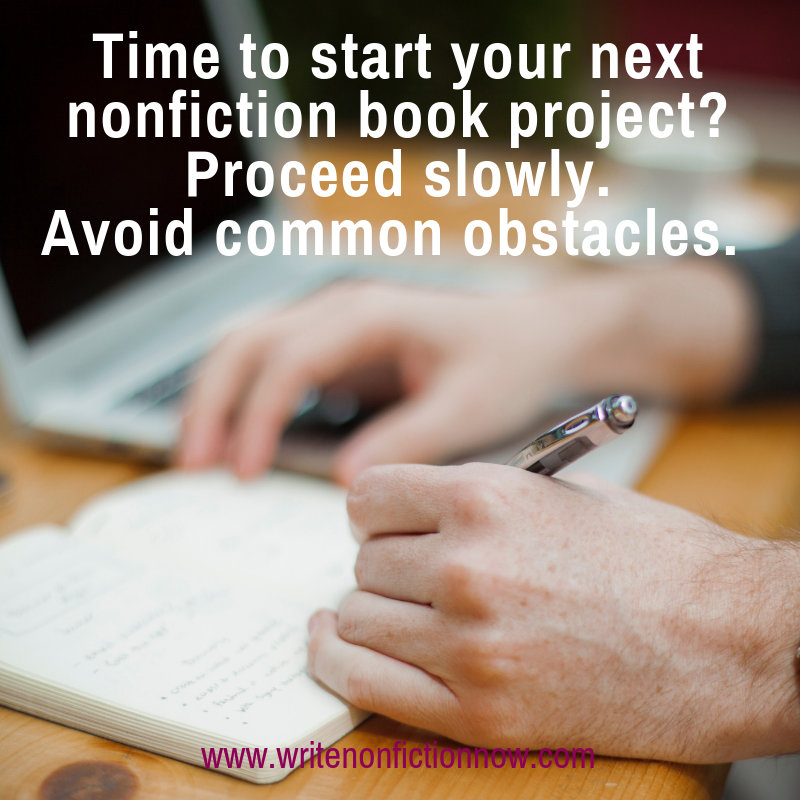Wednesday, October 10, 2018

Once you’ve completed that first big nonfiction book project, you might think the second one will be without challenges. Wrong…unless you approach this new project correctly. Today, book editor
C.K. Bush (
@theladyck) explains how to avoid the three most common challenges faced by nonfiction writers ready to move on to the next big writing project.
One of the greatest pleasures of my work as an editor is receiving a new project from an author with whom I’ve previously worked. At that moment, I’ve gone from being
their editor on one project to
their editor. Period. We now have an ongoing relationship, one that speaks to a mutual trust and confidence in each other’s work. In my profession, those relationships are the ones we cherish.
When the second nonfiction book project comes around, though, there are a host of new challenges. As someone’s dedicated editor, I try to use the ongoing relationship as an opportunity to help an author navigate these issues. A first major writing project is passionately conceived and often close to the author’s heart; after all, the prospect of writing it is what compelled the author to become an author in the first place. In writing a second big piece, the how—and when—to write it isn’t necessarily the same. The reception of the first piece, the author’s career choices, and the demands of taking on something new after so much time spent on the first topic all complicate getting started on this new writing project.
Let’s walk through the common issues that my nonfiction authors face when getting ready to write their second big book project. Overcoming them can feel hard, but it’s not impossible. And the solutions to these issues are more straightforward than you might think.
#1: I need to write something now!
When an author’s living depends on writing, they are want to have a steady stream of projects to keep their income as constant as possible. Most of the authors I work with have a combination of types of writing going at one time—a book for me, an article for someone else, an op-ed for a major newspaper, and so on. They are not entirely dependent on immediately churning out a new book.
Still, I sometimes see nonfiction authors who are in desperate need to get a new book project underway for career advancement or financial reasons. This rush to get cracking on the next project predictably leads to undercooked books, such as ones with unclear theses or disorganized chapters. I almost always need to kick back these proposals to their authors so we can get them to a place where I feel comfortable discussing them with my colleagues as potential new publications.
It’s important to never let panic override your best instincts when developing the ideas for your next project. You might not have the same deep burst of inspiration as you did for the first project, but you shouldn’t rush out with the first thing that pops into your head.
Take a break and think deeply. Allowing more time in the beginning will help the rest of the process move faster in the long run. You won’t need to do as many revisions and reconsiderations midway through to get your work ready for publication.
Never let panic override your best instincts when developing the ideas for your next project.Click To Tweet
#2: Why reinvent the wheel?
If an author’s first big nonfiction book project has been well-received by critics, in book sales, or in social media buzz, often they have an impulse to continue working on the same topic. This is logical—after all, the author has hit on something interesting and developed the necessary expertise to do so. But, this approach can also lead to the author getting into a rut that they don’t necessarily see coming until its too late.
Some authors, trying to turn out a new nonfiction book project quickly (as in scenario #1 above), may work to repackage a previously successful set of research into something that seems new. This almost never works—readers, reviewers, and publishers alike can tell that the author’s latest project isn’t actually a fresh take on the topic.
Becoming an expert writer on a given topic with a suite of interesting publications takes time and effort. Re-writing essentially the same work over and over again is not a shortcut to this success.
I often push authors to go back to their original work and think about the “so what” they never considered and use this unanswered question as the jumping off point for new but related work. A writer might not want to reinvent the wheel, but they ultimately have to do some reinvention to continue to produce quality work.
A writer might not want to reinvent the wheel but must do some reinvention to produce quality work.Click To Tweet
#3: I need to completely reinvent the wheel!Other times, I run into an opposite problem from returning authors: they want to write on an entirely new topic. Professionally, this may be a gamble—if Ronan Farrow, for instance, switched to only writing restaurant reviews, readers who chose to follow his work for its investigative or political reporting would probably stop seeking out his work.
Making a drastic switch in topics also can waste the rich body of expertise a writer has developed. Sometimes the author is not able to develop as good of a sense of expertise on this new topic area.
When an author approaches me with a project that represents a significant shift in what he or she is known for, I counsel them to think carefully about this change. Is there a way to link it to your existing expertise?
A change in an author’s field of study demonstrates versatility and an ability to take on an intellectual challenge. However, a body of work with clear connections and consistent quality of depth and care ultimately does a much better job of reflecting a writers’ true intellectual growth and skill.
Plus, switching to a new subject can delay an author’s new project—especially if they need to build a platform around it, and, as time passes, they might not even finish the piece. For writers writing to make a living, a happy medium between completely old and entirely new might be best.
A happy medium between completely old and entirely new might be best.Click To Tweet
When it’s time for a second nonfiction book project, professional and economic realities are a factor in the writer’s process—maybe more today than ever before. From my editorial point of view, the trick lies in an author’s ability to learn how to balance these realities with the writing process itself. That process contains all the same inherent challenges as it did when the writer worked on the first big project. It’s important not to let the new realities of continuing to be a writer get in the way of the most important thing of all—the creation of a high-quality piece of writing.
What challenges did you encountered when you started your second nonfiction book? Tell me in a comment below.
About the Author
 C.K. Bush
C.K. Bush is a nonfiction editor and writer. She lives in New York City.
Photo copyright: Alejandro Escamilla on UnsplashThe post
How to Avoid Second Nonfiction Book Project Issues appeared first on
Write Nonfiction NOW!.
Nina Amir, the bestselling author of How to Blog a Book and The Author Training Manual, is a speaker, a blogger, and an author, book, blog-to-book, and high-performance coach. Known as the Inspiration to Creation Coach, she helps creative people combine their passion and purpose so they move from idea to inspired action and positively and meaningfully impact the world as writers, bloggers, authorpreneurs, and blogpreneurs. Some of Nina’s clients have sold 300,000+ copies of their books, landed deals with major publishing houses and created thriving businesses around their books. She is the founder of National Nonfiction Writing Month, National Book Blogging Month, and the Nonfiction Writers’ University. As a hybrid author she has published 19 books and had as many as four books on the Amazon Top 100 list at the same time. Her most recent book is called Creative Visualization for Writers, and tomorrow her 19th book will be released, The Write Nonfiction NOW! Guide to Creativity and Flow. Find all her books at booksbyninaamir.com or find out more about her at ninaamir.com.